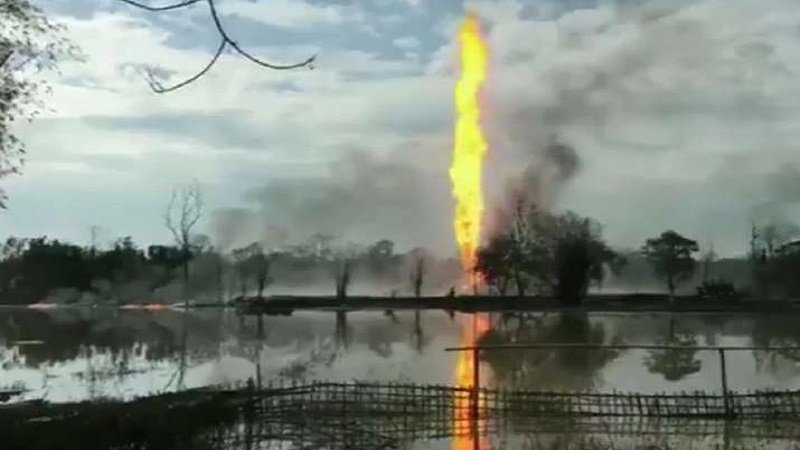Worryingly, the findings of this report are part of a preliminary on-site survey carried out between May 28 and June 2, before fire broke out at the Oil India Limited (OIL) well number 5.
Nikhil Ghanekar: Dead fishes, wilted plants, toxic fumes and a thick film of oil on vegetation, river animals and wetlands – this is the picture painted by an interim report on the environmental damage caused by the oil blowout in Assam’s Tinsukia district.
The Wildlife Institute of India (WII) report, submitted to the Union Environment Ministry, stated that the accident has caused mass mortality, and the environmental conditions succeeding the blowout have resulted in debilitating conditions for species to survive.
Worryingly, the findings of this report are part of a preliminary on-site survey carried out between May 28 and June 2, before fire broke out at the Oil India Limited (OIL) well number 5. A detailed assessment, including the damage done by the blaze, will follow.
The report states that blowout from an oil well spews hundreds of chemicals in the air, water, and the ground, contaminating the impact zone of the disaster and its surroundings. “Hydrocarbon component comprises of organic compounds, many of which are hazardous when released into the environment,” the report explained.
As a result, biodiversity of the Dibru Saikhowa Biosphere, which is spread across the Tinsukia and Dibrugarh districts of the state, has been jeopardised. The biosphere contains the Dibru-Saikhowa National Park and the famous Maguri-Motapung wetlands. According to the report, tissue and blubber samples collected from the carcass of a dolphin calf retrieved from the Maguri Beel – a prominent lake in the area – and sent to check for presence of contaminants.
Hundreds of other species could also risk contamination since the biosphere is home to 500 species of birds, 104 species of fish, 18 species of lizards, 23 species of snakes, 105 species of butterflies and 680 plant species, according to numbers stated in the WII’s report.
The reserve is also home to majestic wildlife species such as tigers, elephants, leopards, bears and the Gangetic dolphin. Moreover it is also categorised as an Important Bird Area – a globally recognised ecosystem that provides a composite habitat for threatened and endangered bird species.
“The toxins released are known to have long-term persistence in soils and sediments, which will not only affect current life conditions, but due to sustained release over a long period, pose a serious health risk for a longer term,” the report added. The impact of the spill and its extent might be amplified due to its occurrence during monsoon season, the report said. This could adversely affect not only the flora and fauna, but also the locals who depend on the rich biodiversity for their livelihood.
Soumitra Dasgupta, Inspector General of Forest (Wildlife), Union Environment Ministry said that it has written to the Assam Chief Secretary, the state’s chief wildlife warden as well as the Petroleum Ministry.
Questioned about whether Oil India will be ordered to pay damages for spill, he said, “WII will submit a detailed report on assessment of the damage. Currently, that is not possible due to the fire that has erupted. Depending on the damage assessment and after looking at the conditions specified in the clearance granted for the project, we will take a call on the ecological restoration.”
Bodies of two firefighters , who died battling the massive, blaze were recovered from a water body near the site of the well on Wednesday. OIL spokesperson Tridiv Hazarika said that the fire had been contained in the peripheral area, and was limited only to the well area now.
“The state forest department has formed a team with different experts to assess the damage and we have also written to NEERI (National Environmental Engineering Research Institute) to do an impact assessment report following the blow out. We have also engaged TERI (The Energy and Research Institute) for bio-remediation,” said Hazarika.
“This is a rare and unfortunate event and our mitigation plans, too, have been tested. The condensate stopped falling after the blaze started and we have engaged local fishermen to mop up condensate from the wetlands using absorbents,” he added.

